Q&A: How Ed Sullivan, girls gone wild, an alligator and blindfold painting shaped the art of Kim Dingle
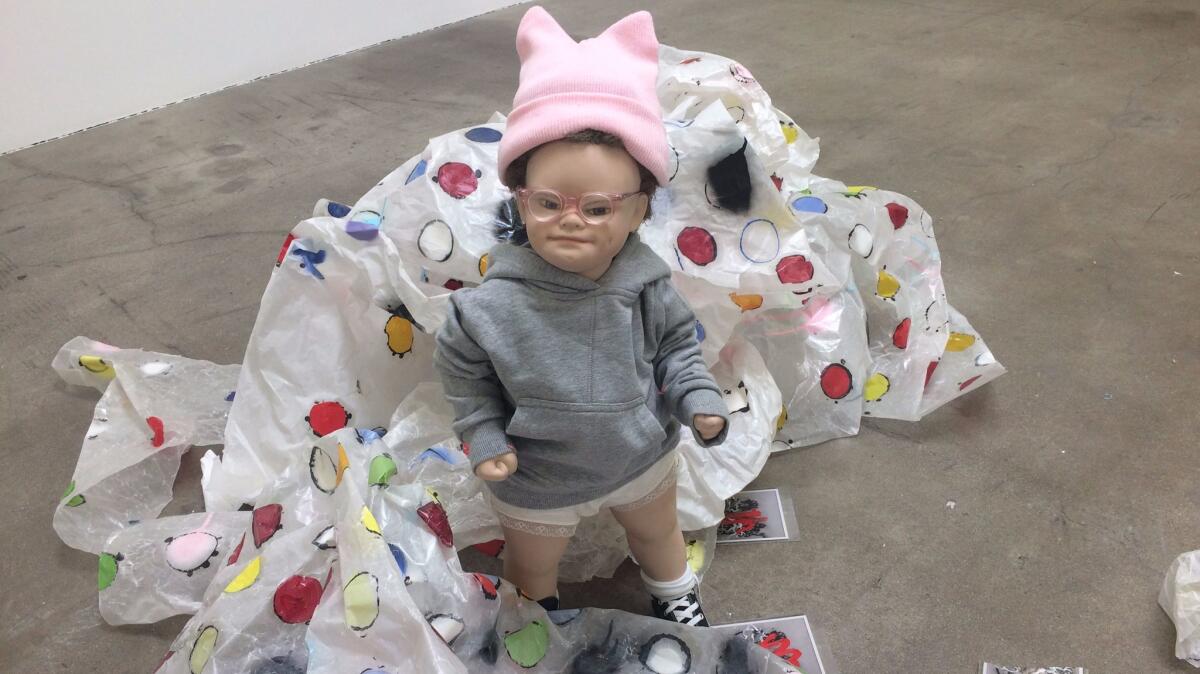
- Share via
If the paintings of Kim Dingle sometimes look as if they’ve been attacked by a 6-year-old gone berserk on a sugar high, it’s probably because they have.
The Los Angeles artist is known for creating paintings and installations that feature little girls in feminine frocks wreaking all manner of havoc. For some of her installs, she will enlist the child of a friend to add the finishing touches: a crayon scrawl on the walls, piles of silly string underfoot, assorted bits of detritus. To help unleash the creative juices, Dingle has been known to supply her workers with generous amounts of candy.
“Sometimes I need an assistant,” she deadpans. “A very short assistant.”
Dingle’s unorthodox working methods are on view at Susanne Vielmetter Los Angeles Projects in Culver City through Saturday, where she is displaying a number of works new and old.
This includes an installation that features her destructive little girls — which she first began making in the 1990s. It also features an assortment of new works, such as her recent “Crush” paintings — a series that functions a bit like a copy of a copy of a copy. The paintings begin as works on glassine, which she then photographs. Then she paints over the photograph to create the final painting. The glassine is then displayed in a crumpled stack on the floor before the final painted work like a postmodern diptych.
In addition, there is a series of abstractions inspired by the patterns of construction boards she acquires at Home Depot.
But perhaps the most sensational pieces are Dingle’s “Blindfold Paintings,” in which she renders her demonic little girls in broad expressive brushstrokes while wearing a blindfold. (For the doubters: the gallery contains video of Dingle painting with her eyes covered.)
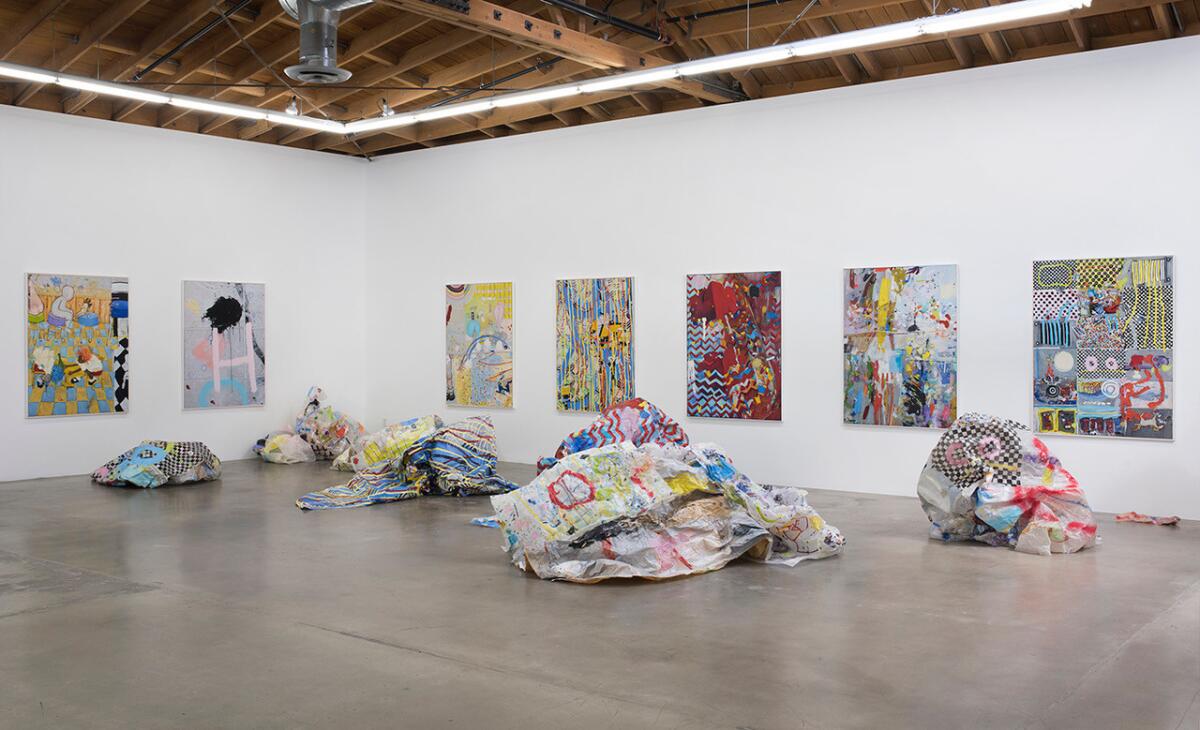
The show at Vielmetter marks another step in Dingle’s comeback as an artist.
For a dozen years, she and Aude Charles operated the Eagle Rock restaurant Fatty’s, where Dingle says she served as “the director of wine and janitorial.” She returned to the art world in 2013, after selling the business, with a show at Coagula Curatorial that she dubbed “Kim Dingle’s Wine Bar for Children at Mister Ling’s Market.” (Dingle has a wicked sense of humor, making acerbic wisecracks about her own work and others. She also likes to refer to Vielmetter, who was born in Germany, as “Kaiser Vielmetter.”)
The artist’s return has been thus far well received. Times reviewer David Pagel described her show at Vielmetter as “fearless” in a recent review. Certainly, Dingle isn’t afraid of trying new things. She took time to chat about how Ed Sullivan and a manicured alligator inspired her work, how she avoids being typecast as a painter and how being blindfolded requires a whole new level of perception.
Little girls in Western painting are often depicted as these placid, innocent creatures. Yours are the opposite. Is your work a reaction to the stereotypical portrayal?
I’ve seen those. It’s the nice portrait of the girl with the dog you put on the mantel. But I never really had that thought. My girls are pit bulls.
How did you come to paint little girls to begin with?
I was in the old
So I’m looking at this portrait of so-and-so as a little girl and she is standing there with this total old-man face because the limner wasn’t any good. And I thought, “Ed Sullivan as a Little Girl.” And I put it in my notebook and I carried it around for 10 years. I got to graduate school at Claremont — 1980, 1990 — and I pulled out my notebook. I had wanted to paint it for years but didn’t know how to paint it. But I finally painted it.
I laughed so much. It came out really bad. It’s Ed Sullivan’s face on a little girl with her arms crossed and her hair pulled back really tight so she has the Ed Sullivan hairline. That is a painting I kept.
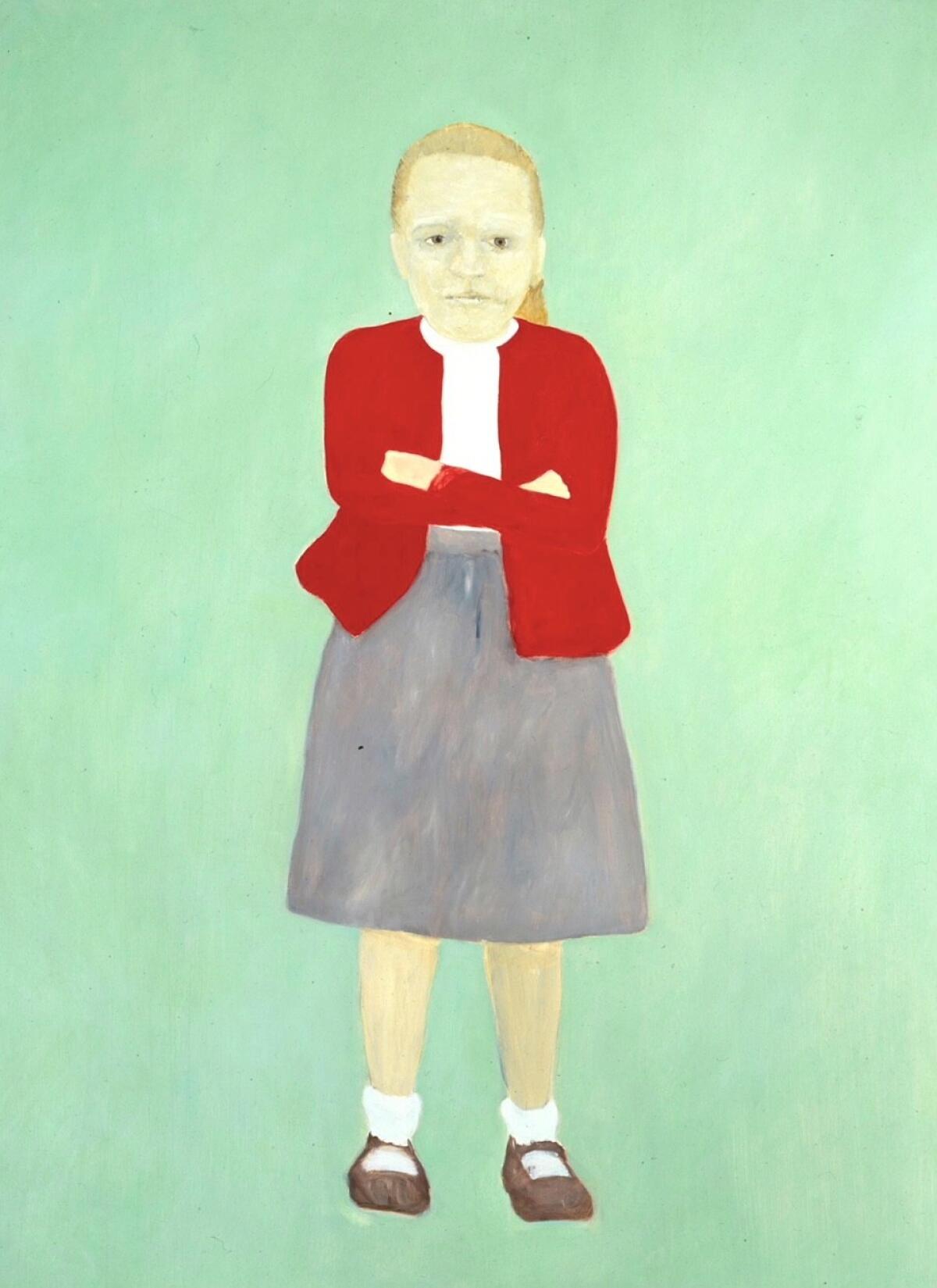
You often depict girls in the frilliest, most feminine outfits acting totally feral. How did you arrive at that look?
My niece, my oldest brother’s little girl, he used to bring her over. She has a blond ’fro, kind of a loose tumbleweed, and brown, beady eyes. I tell her all the time she is the origin of these. She would always be in these crunchy, lacy, mid-thigh dresses that would be so starched. Her dress would be really feminine, but she would have these tantrums. She’d bang her head against the wall. She lacked oxygen at birth, so she has issues. She’d be really feminine one minute and then she’d take off and have these violent outbursts — wearing these ultra-feminine dresses and her Mary Janes. Priss has her hair.
How did you come up with the name Priss?
[The ex-husband of my former gallerist Kim Light] had a vicious alligator and he had painted its toenails pink and named her “Priss” because it was so contradictory to her looks. I laughed so hard when I heard he’d painted her nails with his mother’s nail polish. I never met the alligator. But I imagine this alligator’s mug right now with its painted nails and its eyes. These girls were like alligators, so it was “Priss.”
That was the middle of the ’90s. Who knew I’d be stuck with “Priss.”
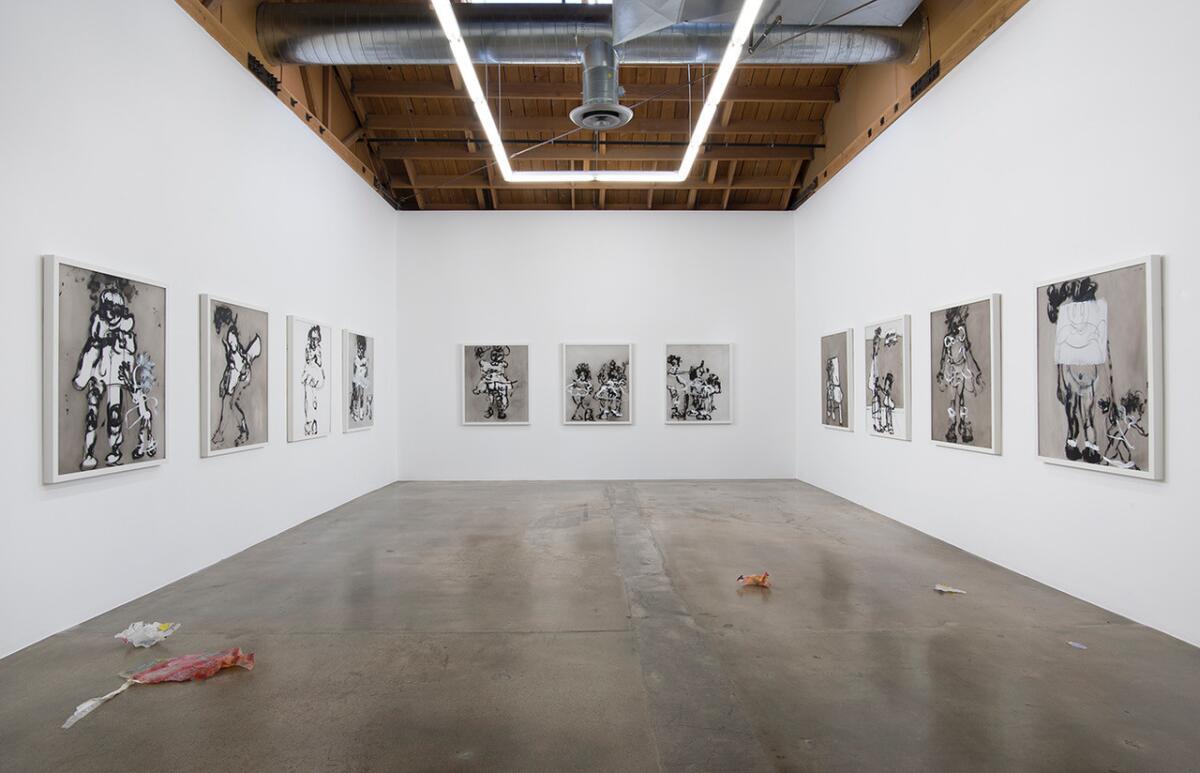
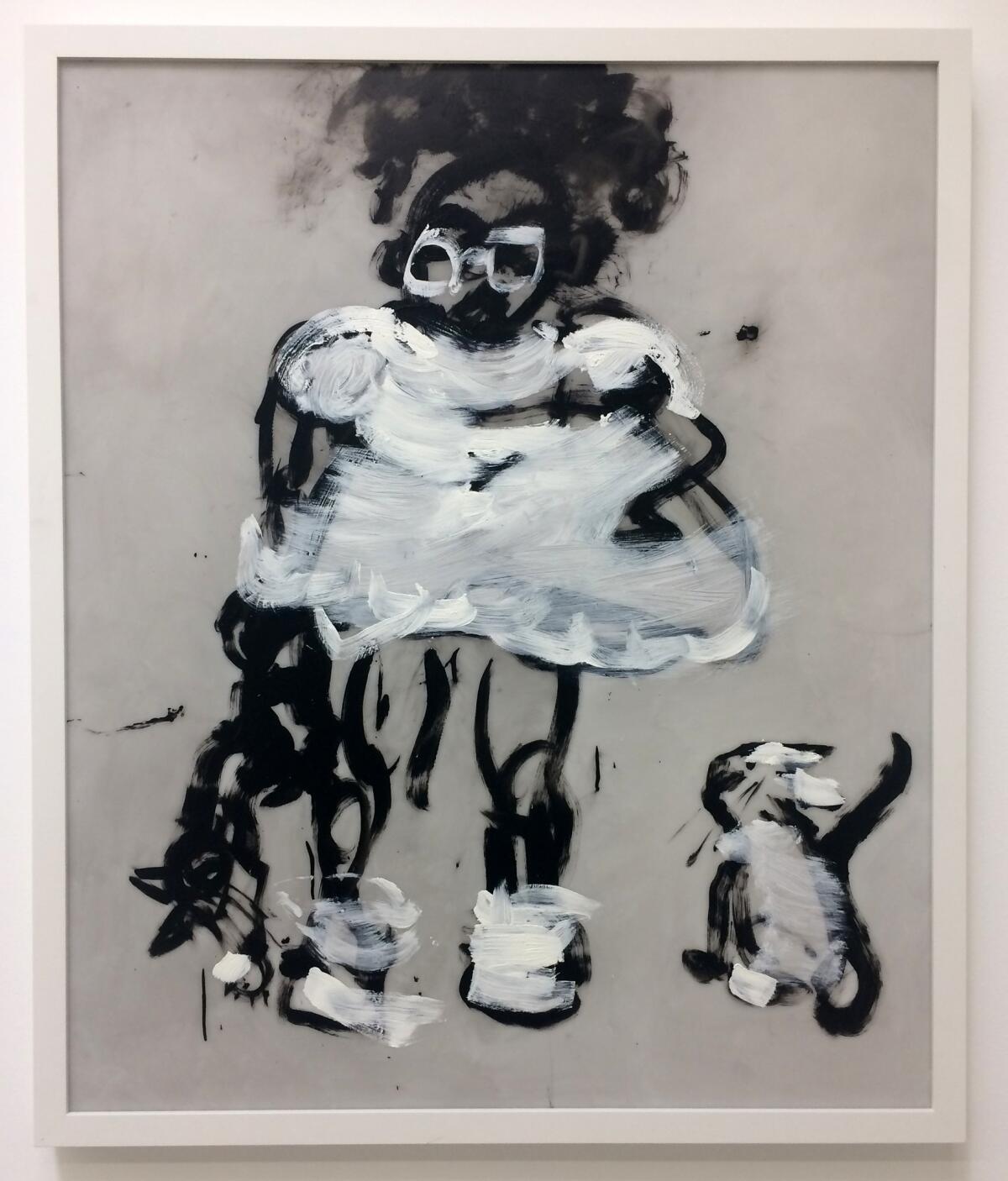
Is Priss an alter ego?
She’s a device. It’s really the materials that get me going. I want to see how things work, to experiment. I didn’t want to do little girls anymore. But Kaiser Vielmetter — that’s what I call her — likes the little girls. I wasn’t looking to have a show, but she said the most diplomatic thing that a dealer has ever said to me. She said, “Invite me to your studio.”
I wasn’t painting little girls. I’d been working on other stuff. I don’t want to make what people might think of as a brand. I cannot do a commission. I can’t do what somebody might want me to do. It’s physically impossible. That is the downfall for so many artists — the art market and too many galleries and all of those things. It’s artists thinking, “Oh, they will like this.” But what you’ve done is just jumped on your grief pole to hell.
I complained to Kaiser Vielmetter so much. I heard myself saying, “I could do these blindfolded!” And like the 10th time I said that I was like, “Hmmm. Blindfolded. I better do that.” It was a technique and a challenge. You are using your senses and every fiber of what you know. You use your hands. You use your touch. It could have been such an utter failure.
How did your abstract painting series “Home Depot Coloring Books” come about?
I had built a wall in the middle of the studio and I it was made from OSB [oriented strand board]. It’s used in homes and behind drywall. Most galleries have it behind their drywall. I had sheets of them laying around and I’d use them as a table. So I’d been sitting at that table and staring at the patterns of the oriented strand board. It’s not particle board. It’s strands, these big pieces of wood. And right in the middle of this Kaiser Vielmetter show, I just made them. They took months. You are making decisions every few seconds. It tells you what color it wants to be. It was very meditative for me and the results are really surprising. There is a beauty there. It’s a natural order you are finding.
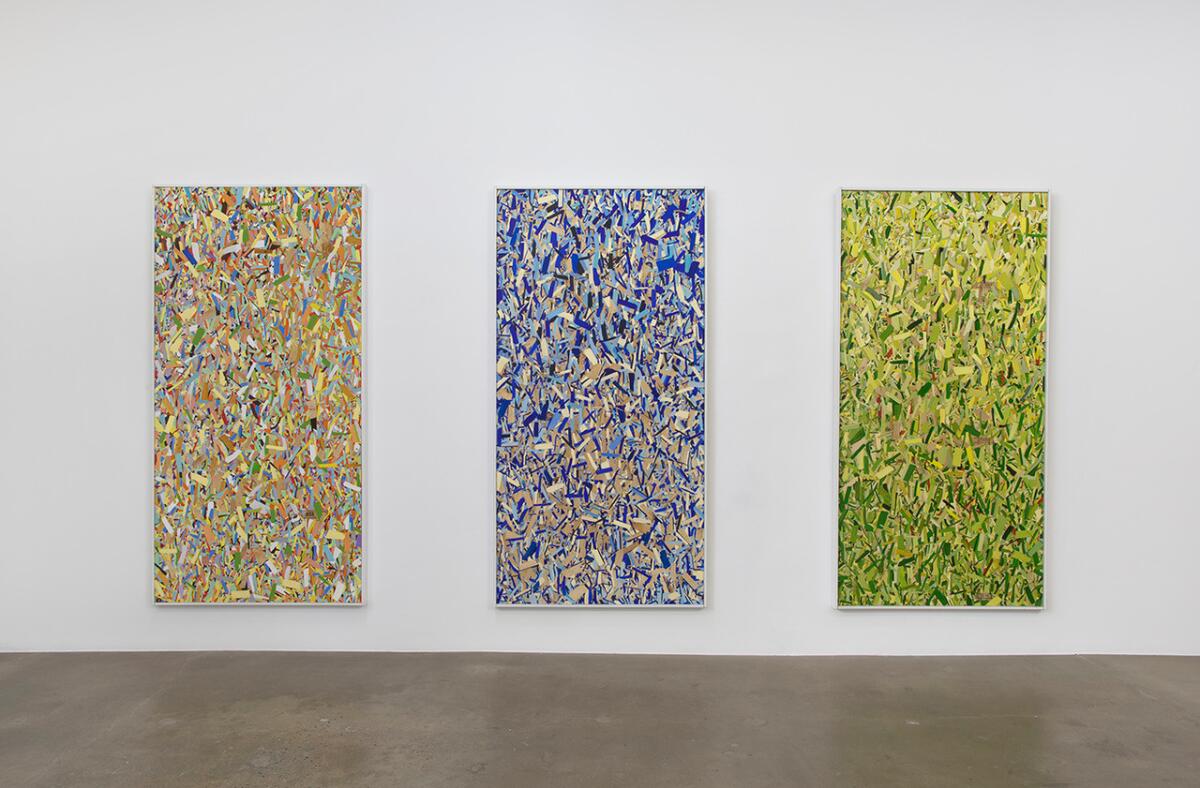
You’ve talked about your frustration with being known as the painter who does little girls. How do you avoid falling into an artistic rut?
I’ve always done abstractions. I’ve done maps. In the ’80s, when I was an undergrad, I was a house painter. [Laughs.] I love art, but I’m not going to do it for the money or to please people, to give them whatever they want. So I have what I call the “Richter Rule.”
[Painter]
So I have my Richter Rule. So that’s what I do. Kaiser Vielmetter and I, we signed a truce, the Treaty of Versailles. If she is going to show the girls, then we show other things too.
What else are you experimenting with?
I’ve been working on a painting for a couple of years — under a pseudonym. I can’t say the name. It’s really just to make fun of these young, white guy, zombie formalist painters. As much as I’m making fun, though, it needs to be beautiful.
And I still have a few more to do of the blindfolded works. I’m going to attempt [Picasso’s] “Guernica.” I’m going to attempt something that is not a little girl. Except guess what? “Guernica” is full of women and children.
Kim Dingle: “Yipes!”
Where: Susanne Vielmetter Los Angeles Projects, 6006 Washington Blvd., Culver City
When: Through Saturday
Info: vielmetter.com
ALSO
Kim Dingle lets her alter ego loose, and the result is a rip-roaring ride
Kim Dingle debuts 'Wine Bar for Children' at Coagula Curatorial
Stories of the Plush Pony: Vincent Price Art Museum pays tribute to a working-class lesbian bar
The 'whoa' moment and Mary Corse: The painter who toys with light is finally getting her due
The biggest entertainment stories
Get our big stories about Hollywood, film, television, music, arts, culture and more right in your inbox as soon as they publish.
You may occasionally receive promotional content from the Los Angeles Times.








